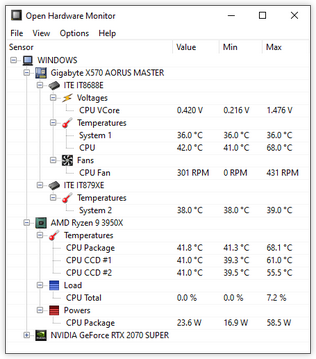- Fixed an error where loading config files from previous versions would crash the application.
- Added a RAM sensor for used memory.

The Open Hardware Monitor is a free open source software that monitors temperature sensors, fan speeds, voltages, load and clock speeds of a computer.
The Open Hardware Monitor supports most hardware monitoring chips found on todays mainboards. The CPU temperature can be monitored by reading the core temperature sensors of Intel and AMD processors. The sensors of ATI and Nvidia video cards as well as SMART hard drive temperature can be displayed. The monitored values can be displayed in the main window, in a customizable desktop gadget, or in the system tray. The free Open Hardware Monitor software runs on 32-bit and 64-bit Microsoft Windows XP / Vista / 7 / 8 / 8.1 / 10 and any x86 based Linux operating systems without installation.
Latest News
Release Version 0.5.1 Beta
Release Version 0.5.0 Beta
- The Open Hardware Monitor has a new remote web client developed by Prince Samuel. This allows to monitor the sensor values remotely from any web browser.
- Added support for Intel Ivy Bridge based CPUs.
- Added support for RAM hardware and implemented sensors for load and available memory.
- Added support for SSDs with a controller from Micron.
- Corrected the Sandforce SSD identification.
- Added a write amplification sensor for Sandforce based SSDs.
- Added a load sensor for hard drives that shows the used space in percent.
- Added temperature offset parameters to all hard drive temperature sensors.
- Added support for ITE IT8705F and IT8771E super I/O chips.
- Added support for Nuvoton NCT6779D super I/O chips.
- Andrey Mushatov added support for Fintek F71808E super I/O chips.
- Added mainboard specific configurations for the following ASUS maiboards: P6T, P8Z68-V PRO, P8Z77-V, P9X79.
- Added mainboard specific configurations for the following Gigabyte mainboards: EX58-UD3R, G41M-Combo, G41MT-S2, G41MT-S2P, GA-MA770T-UD3P, GA-MA785GM-US2H, GA-MA78LM-S2H, GA-MA790X-UD3P,
- H55-USB3, H55N-USB3, H61M-DS2 REV 1.2, H61M-USB3-B3 REV 2.0, H67A-USB3-B3, P55A-UD3, P67A-UD3-B3, P67A-UD3R-B3, Z68A-D3H-B3, Z68AP-D3, Z68X-UD3H-B3.
- Added support for reading more than one T-Balancer fan controller.
- Added an option to enable/disable the monitoring of any hardware group (Mainboard, CPU, RAM, GPU, Fan Controllers, HDD).
- Added a simple way to customize the sensor desktop gadget background: If any of the files gadget_background.png, gadget_image.png, gadget_foreground.png, gadget_bar_background.png or gadget_bar_foreground.png are present in the working directory then these images are used instead of the default ones.
- The temperature in the system tray icons are now shown correctly in Fahrenheit when using Fahrenheit as temperature unit.
- Fixed the problem of missing tray icons after Windows startup.
- Fixed the system tray icon font scaling for Windows XP.
- Improved the data compression for storing the recorded sensor values in the configuration file.
- Changed the license to the Mozilla Public License 2.0 and update the licensing information.
Release Version 0.4.0 Beta
- Added an option to show the sensor-plot in a separate window or on the right of the tree-view.
- Added support for saving and restoring the sensor history as shown in the plot for the last 24h.
- Added a context menu to the plot which allows the user to configure the time window for plotting.
- Added code to save and restore the plot sensor selection.
- Added support for AMD family 12h (Llano) and 15h (Bulldozer) CPUs.
- Added support for package level temp sensors on new Intel Sandy Bridge CPUs.
- Added support for Intel CPU power sensors (package and cores).
- Improved the CPU load sensors. The values displayed for the load per core and the total load should now be more accurate.
- Rewritten the SMART HDD and SSD monitoring code based on a patch by Roland Reinl. The report now contains a list of all SMART attributes with the labels as identified by the Open Hardware Monitor.
- Added support for SMART total host writes and total host reads sensors on SSDs.
- Further restricted the identification for Indilinx SSDs to prevent Maxtor HDDs to be identified as Indilinx SSD.
- Added the hard drive firmware version to the report.
- Added support for the Fintek F71889AD super I/O chip.
- Added support for the ITE IT8772E super I/O chip.
- Added support for fan control on the NCT677X super I/O chips.
- Added fan control for Nvidia GPUs based on a patch by Christian Vallières.
- Extended the identification list of mainboard manufacturers.
- Added mainboard specific configurations for the Gigabyte Z68X-UD7-B3, ASUS P8P67, ASUS P8P67 EVO, ASUS P8P67 PRO and Shuttle SH67Hx mainboards.
- Added a third decimal place for voltages to the displays.
- Optimized the memory allocation behavior of the GUI.
Release Version 0.3.2 Beta
- Fixed the message box that is shown when the Open Hardware Monitor is started without extracting all files from the archive.
- Fixed a spelling error in the report submitting dialog.
Release Version 0.3.1 Beta
- Added an option to edit hardware names in the user interface.
- Voltages are now shown with three decimal digits in the main user interface.
- Added support for the IT8728F super I/O chip used on Sandy Bridge mainboards from Gigabyte.
- Fixed a few problems in the NCT677X super I/O implementation.
- Added a mainboard specific configuration for the ASUS P8P67-M Pro, Gigabyte P67A-UD4-B3 and Gigabyte H67A-UD3H-B3.
- Fixed the bus and core clock reading on AMD Phenom II X6 CPUs with Core Performance Boost.
- Fixed the ATI GPU fan control. The settings now restore correctly to the default on all systems.
- Fixed a few exceptions that forced the Open Hardware Monitor to terminate.
- Added a few tweaks to the main user interface to get better font rendering when ClearType is disabled in Windows.
- Added code to move the gadget back to the visible part of the screen when its current position is no longer visible.